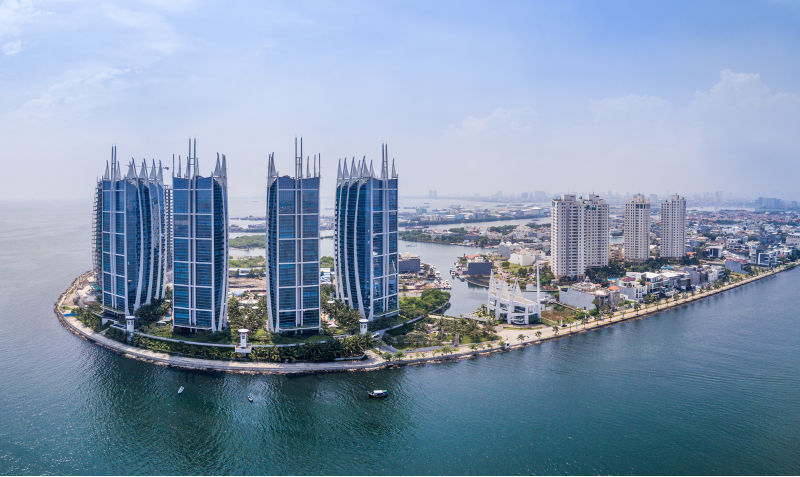Not waving, drowning – Indonesia may lose warming battle
July 11, 2025
This is the way the world ends, not with a bang but a flooding: With apologies to T. S. Eliot
Every year the UN runs a Climate Change Conference – the next is scheduled for November in Brazil. High on the agenda will be the plight of Pacific Islanders seeing their homes drown. There’s an equally pressing need close by, but the solutions seem doomed.
Indonesian authorities provide useful information for travellers checking if they’ve got to the right place: alongside the destination name is its height above sea level.
Surabaya, the capital of East Java, advertises it’s just two metres higher than the nearby waves. The Republic’s second-biggest city is a vital transport hub, a humid home to ten million and a trading and naval centre for more than a thousand years.
How many more is the figure to fear.
For the waters are rising and the beaches are drowning, most strikingly in the capital Jakarta 780km west along the coast of the Java Sea. It’s disappearing faster than any other city in the world, according to a BBC report:
“North Jakarta has sunk 2.5 metres in 10 years and is continuing to sink by as much as 25 centimetres a year in some parts, which is more than double the global average for coastal megacities.”
Global warming is a factor but the other culprits are illegal drilling for groundwater and excavating foundations for high-rise towers and a web of toll roads. Despite the predictions the rattle of pneumatic drills, the slurp of concrete pours and the nodding of dinosaur construction cranes continues day and night.
The BBC’s depressing information was broadcast seven years ago; horizontal lines drawn by shack owners on their timber walls to measure the rise are now invisible under the brown soup of plastics, nappies, cans and other trash that passes for water.
Lab-coated scientists taking samples to prove the pollutants are extreme would need extra protection because corrosives rot clothing.
So, what to do?
The last president Joko ‘Jokowi’ Widodo decided the solution was to move. He reckoned the right place to raise a memorial to his foresight was 1200 km north-east of the descending capital. The first building rising above the greenery has been the palace.
This is East Kalimantan province on the island of Borneo, the biggest in the sprawling 17,000-island archipelago where orangutans once outnumbered their human relatives. That was before the timber cutters and palm-oil planters arrived to turn the pristine into profit.
Java is five times smaller than Borneo but immeasurably more important – the political, administrative and cultural centre of the Republic and home to more than 158 million. It’s the world’s most densely populated island and super-fertile, though much of the landscape is mountainous.
The proverb rindu kampung halaman means more than just a longing for home. It embraces family, community, culture, local language and history. For the Javanese, these magnets of birthplace exercise a powerful pull.
So the four million bureaucrats and their families who call Jakarta their place are not dashing to shift to East Kalimantan with its different climate and culture – now grandly titled Ibu Kota Nusantara, the Mother City of the Outer Islands.
Despite their city’s mess, many workers will need more than subsidies and promises of promotion to get them to move, particularly if they have partners and kids embedded in schools, sports and friendships.
All this along with a disinterest in tipping more money into the Jokowi ego monument is why his successor, President Prabowo Subianto, is pondering other ways to keep Jakarta residents above water.
The current favourite is the Great Wall of Java, already on the list of strategic projects in the 2025-2029 National Medium-Term Development Plan, though there are still no blueprints.
As a former military man before being cashiered in 1998, Prabowo sees rising seas as an invasion, so the best defence is fortification.
There are lessons from military history he needs to heed. The collapse of the French Maginot Line in 1940 showed that barricades are only as strong as their weak spots and there’ll be many as seas surge and waves undermine the president’s bulwark.
Like Canute, he can shout orders. But king tides only obey the pull of the moon.
So far, estimates of Great Wall measurements and costs are still being splashed around conference tables, but the best published stab is 500km and A$122 billion over two decades. That’s twice the current estimated cost of Jokowi’s IKN.
The figures are certain to rise faster than sea levels. The money will have to be drained from state budgets as the project is unlikely to attract even Chinese investors reportedly propping up IKN. How do you earn money from a venture trying to tame nature?
One idea is to build “a livable seawall that has residential and commercial zones, essentially turning the whole structure into a kind of floating city”. Swimming would be a required skill for buyers.
The omens aren’t good. Earlier attempts to build Jakarta dykes failed. One collapsed in 2007, five years after construction – no defence against a storm that took 80 lives.
_The Jakarta Post_ is not a cheerleader for the Prabowo plan: “Simply put, we don’t have enough money or possess the knowledge or experience to build the Java seawall… We could end up with another unfinished massive construction by the end of the current presidential term, only this time at sea.”
Maybe delegates to the UN Climate Change Conference will offer fresh solutions. Otherwise like Shelley’s Ozymandias, Prabowo’s mighty works will remind future generations how we lost the battle against global warming.
The views expressed in this article may or may not reflect those of Pearls and Irritations.

